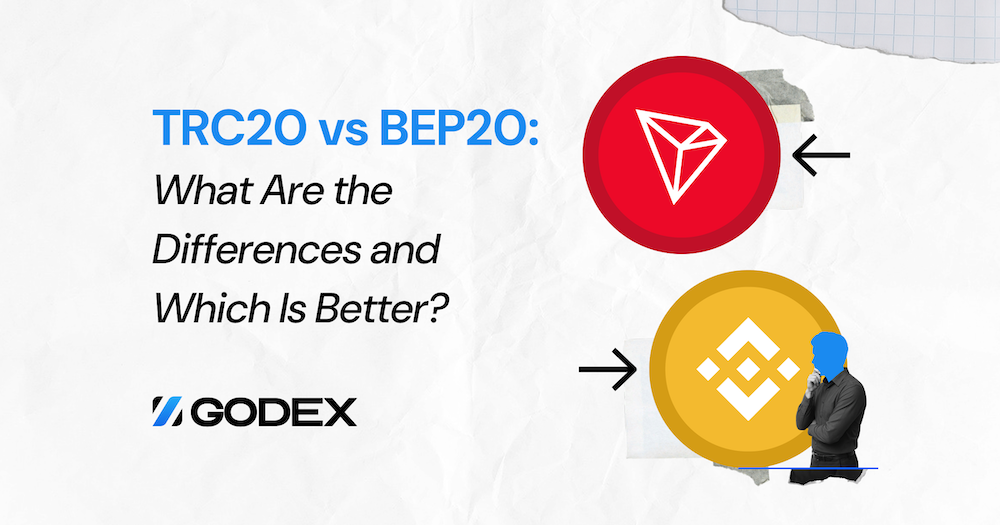Table of Contents
To understand BEP20 vs TRC20 better, think of a specific franchise that includes various gas stations. Across all of them, drivers can use fuel points, which represent BEP-20 tokens. As long as you’re within the Binance ecosystem, these tokens enable transactions, payments, and other services efficiently.
In contrast, imagine a fast and efficient metro system leveraging the only token within its transportation network, with passengers taking advantage of its speed and affordability compared to other transport options. This is how TRC-20 tokens are used within the TRON blockchain.
In this article, we’ll define TRC20 vs BEP20 and which is better in terms of performance, costs, scalability and security. Let’s get started!
TRC20 vs BEP20: Key features and differences
Both tokens provide a foundation for digital assets, decentralized finance (DeFi) projects, and blockchain-based applications. Let’s find out what their standards are and how they rule internal processes in the blockchains.
BEP20 vs TRC20: Understanding the Standards
If you want to transfer tokens, check balances, and interact with smart contracts, the standards define how these operations are performed. BEP-20 is the token standard for the Binance Smart Chain (BSC), while TRC-20 applies to the TRON blockchain.
Now, what are the key differences between BEP20 vs TRC20?
- Transaction Speed & Costs: Binance Smart Chain offers low fees but operates within a slightly different consensus mechanism. TRON is known for its high-speed transactions and extremely low fees, making it ideal for microtransactions and frequent trades.
- Consensus Mechanism: TRON relies on Delegated Proof of Stake (DPoS), where 27 elected validators manage transactions. BSC uses a Proof of Staked Authority (PoSA) system, where validators stake BNB to secure the network.
- Blockchain Compatibility: Both operate on different networks. This means they are not natively interchangeable and require bridges or conversion mechanisms to transfer assets between these blockchains.
TRC20 vs BEP20: Technology and Use Cases
The TRON blockchain leverages the Delegated Proof of Stake (DPoS) mechanism for faster transactions and lower fees, with TRC20 tokens supported by the TRON Virtual Machine (TVM) for smart contracts and dApps.
Binance Smart Chain (BSC) employs a Proof of Staked Authority (PoSA) model for efficient transactions, and BEP20 tokens are compatible with the Ethereum Virtual Machine (EVM), enabling easy porting of Ethereum-based applications.
How can traders or blockchain users use BEP20 vs TRC20?
- Both TRC20 and BEP20 tokens are extensively used in DeFi platforms. For instance, JustLend on TRON and PancakeSwap on BSC enable users to lend, borrow, and earn interest on their crypto assets.
- BEP20 tokens facilitate interoperability between BSC and other blockchains, enabling assets to move seamlessly across different networks. TRON’s TRC20 tokens also support cross-chain functionalities, enhancing liquidity and accessibility.
- BEP20 tokens are utilized in BSC-based games and NFT platforms, such as Battle Pets, allowing players to own and trade in-game assets. Similarly, TRC20 tokens are used in TRON-based gaming platforms, enabling seamless transactions within games.
- Each of the TRC20 vs BEP20 tokens is used to represent real-world assets, such as real estate or stocks, on the blockchain, enabling fractional ownership and increased liquidity.
- Stablecoins like USDT are issued as TRC20 tokens on TRON and as BEP20 tokens on BSC, providing users with faster transactions and lower fees compared to other networks.
- Both token standards are employed in payment gateways, allowing merchants to accept cryptocurrencies with reduced blockchain transaction fees and swift settlement times.
TRC20 vs BEP20 Fees: Transaction Costs and Gas Fees
Both are perfectly fine for transferring tokens affordably. However, if you’re looking for the cheapest way to transfer tokens, TRC20 is the better option due to its near-zero fees. But if you need Ethereum compatibility and access to Binance’s ecosystem, BEP20 is a great alternative with low fees compared to ERC20.
Transaction costs are also called gas fees. They are defined by each blockchain’s consensus mechanism, network traffic, and transaction validation process. Let’s elaborate on the gas fees of each blockchain.
Which one of the TRC20 vs BEP fees is cheaper?
- TRC20 is more cost-effective for high-frequency transactions, thanks to its resource system allowing for free transfers if resources are pre-allocated.
- BEP20 still offers low fees, but users need to maintain BNB for gas, and fees can rise depending on network congestion.
TRC20 vs BEP20: Which Is Better for Your Needs
Users’ needs for TRC20 vs BEP20 tokens depend on their financial activities, transaction frequency, and application requirements. Both standards cater to specific use cases. We’ll name the most common ones:
- When users want to send, receive, and trade tokens with minimal fees, avoiding the high costs associated with Ethereum-based tokens (ERC20).
- Traders, investors, and businesses require fast confirmations for payments, trading, and smart contract executions.
- Users need flexibility in transferring assets between blockchains or using their tokens across multiple ecosystems.
- Businesses and individuals need stablecoins (e.g., USDT) with fast, low-cost transfers for remittances and payments.
- Developers require a reliable and efficient blockchain for building decentralized applications (dApps) and deploying smart contracts.
Performance and Scalability
Speed is probably the number one performance factor each of TRC20 vs BEP20 tokens can boast of. They are designed to facilitate high transaction speeds and low fees. The second one is cost-effectiveness, thanks to the Delegated Proof of Stake (DPoS) consensus mechanism and the Proof of Staked Authority (PoSA) consensus model, respectively.
What are scalability factors?
The more transactions the blockchain can handle, the more scalable it is considered. The blockchain TRON boasts extensive scalability, capable of managing over 2,000 transactions per second without delays.
Similarly, BSC is designed to support a large volume of transactions, offering a scalable solution for decentralized applications and token transfers.
Security and Reliability
Blockchain infrastructures and consensus mechanisms define the security and reliability of TRC20 vs BEP20. The consensus mechanism of the TRON blockchain suggests 27 validators to secure the network, aiming to enhance transaction speeds and scalability.
However, the TRON network’s moderate security level may not match that of more decentralized platforms. Additionally, smart contracts governing TRC20 tokens can be vulnerable to programming errors, such as reentrancy and improper access control, potentially affecting token integrity.
In contrast, the consensus model of the Binance Smart Chain involves 21 validators staking BNB to secure the network. This structure may result in a lower degree of decentralization, potentially impacting the network’s overall security.
The security of tokens also heavily depends on the quality and security of the smart contracts deployed, as vulnerabilities in contract code can be exploited, undermining token reliability.
Conclusion
TRC20 vs BEP20 which is better? You have to define what matters for you the most: transaction speed, cost-effectiveness, or security. Both do great at this, but each excels in different aspects.
If low transaction fees are your priority, TRC20 is the better option. If you value Ethereum compatibility and ecosystem access, BEP20 is the way to go. Finally, if security is your main concern, TRC20 is relatively more secure than BEP20.
Ultimately, the best choice depends on your use case. If you’re looking for fast, cheap transactions, TRC20 is superior. If you need versatility, Ethereum interoperability, and access to Binance’s ecosystem, BEP20 is the stronger option.
FAQ
Which blockchain has better security: TRC20 or BEP20?
In this TRC20 vs BEP20 contrast, TRC20 tokens on the TRON blockchain generally offer better security due to their Delegated Proof of Stake (DPoS) mechanism, which enhances network stability and reduces vulnerabilities.
BEP20 tokens, meanwhile, on Binance Smart Chain (BSC) use a Proof of Staked Authority (PoSA) model, which, while efficient, has fewer validators, potentially making it more centralised and susceptible to security concerns.
Are TRC20 tokens more scalable than BEP20 tokens?
Yes, TRC20 tokens are generally more scalable than BEP20 tokens. TRON’s infrastructure allows it to handle over 2,000 transactions per second with low fees, while Binance Smart Chain, though efficient, faces occasional congestion due to its Ethereum Virtual Machine (EVM) compatibility.
Which is more cost-effective: TRC20 or BEP20?
TRC20 tokens are more cost-effective than BEP20 tokens because TRON’s resource model allows users to freeze TRX and conduct transactions with little to no fees, whereas BEP20 tokens require BNB for gas fees, which can fluctuate based on network demand.
Can you use TRC20 tokens on the BEP20 network?
No, TRC20 tokens cannot be directly used on the BEP20 network. However, users can utilize cross-chain bridges to convert TRC20 tokens into BEP20-compatible versions, enabling them to operate within the Binance Smart Chain ecosystem.
Start a Cryptocurrency exchange
Try our crypto exchange platform
Disclaimer: Please keep in mind that the content of this article is not financial or investing advice. The information provided is the author’s opinion only and should not be considered as direct recommendations for trading or investment. Any article reader or website visitor should consider multiple viewpoints and become familiar with all local regulations before cryptocurrency investment. We do not make any warranties about reliability and accuracy of this information.
 Alex Tamm
Alex Tamm 
Read more
EOS is definitely on the list of the strongest and most stable projects in the crypto world. Despite the fact that the currency entered the market less than 3 years ago, it consistently occupies one of the top 10 places in the rating for project capitalization. it is often called the “main competitor of Ethereum”. […]
Ripple (XRP) price has been widely discussed by the cryptocurrency community since it has gained public interest in 2017, even though it was founded by Chris Larsen and Jed McCaleb years before. The platform offers innovative blockchain solutions for the banking sector and has the potential to disrupt the whole finance industry. In recent years, […]
In this article we will talk about Ripple (XRP) and its price prediction. What is Ripple (XRP) Ripple is a San Francisco-based startup that was launched in 2012 by Ripple Labs as a global network both for cross-currency and gross payments. Ripple history began in 2004 with the discussions around the digital coin in the […]
You may well think that an article dedicated to a Tether price prediction or the Tether price in general is a little bit strange — it is a stablecoin after all. However, the price of Tether does fluctuate significantly, although it is nowhere near as volatile as non-stablecoin cryptos. This means that staying up to […]
In the article we share our vision at Zcash cryptocurrency main features and add several price predictions. As cryptocurrencies gain global acceptance and decentralisation slowly enters our lives, privacy becomes the main concern when talking about blockchain adoption. It is no secret that distributed ledger is by far the most secure and transparent technology ever […]
Chiliz coin (CHZ) offers a compelling opportunity for traders interested in the intersection of blockchain technology and sports. By enabling fans to influence team decisions through the Socios app, Chiliz directly monetizes fan engagement and connects with major sports teams like Juventus and Paris Saint-Germain. These partnerships not only enhance the platform’s visibility but also […]